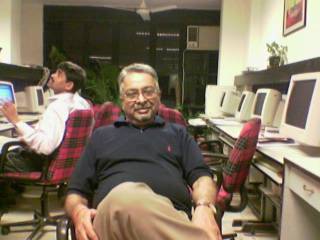
Nothing excites me more than being on the Indian highways. For the third time over the past six months, I decided to hit the highways: from Delhi to Chennai. For a change, I decided to hop onto carriers hauling various items. If the November 2010 Chennai-Delhi trip was on an automotive carrier (Mercurio Pallia carrying Hyundai cars) and February 2011 Jamshedpur-Ludhiana journey was on a steel carrier (Credence Logistics hauling Tata Steel wire rods), this time I escorted – is that the right word! – Tata Ace LCVs (Delhi-Halol), Concrete pipes (Anand-Bombay), Mahindra Tractors (Bombay-Bangalore), plastic granules (Bangalore-Mangalore), Masala packaging material (Mangalore-Coimbatore) and assorted items (Namakkal to Chennai). Over 5,000 kilometres in the searing May heat spread over 23 days.
For a change, this time the interaction en route with various stakeholders: drivers community, transport agents, fleet owners, transport commissioners, director general of police and a memorable visit to Namakkal, the transport city of India. Last, but not the least was the visit the 25 acre Ashok Leyland Driver Training Institute and the upcoming Namakkal Transport College next door and interaction with brain behind these two outfits: one, already established player and another one – one man’s mission to pay back to the industry as a token of his gratitude to the transport industry that helped him etch a name.
I am definitely wiser after this trip. What did I learn this time? Primarily, the transport sector is a split group with the malady of groupism rampant and eating into achieving greater heights. Many organisations that claim to be representing the stakeholders’ interests are not truly run on professional lines. There is very little consensus on issues of general interest to the entire fraternity. Most office bearers of various outfits – without getting into names – are keen of beefing up their own personal empire.
Karnataka emerges as the most corrupt Road Transport Authority regime in the entire country. Perhaps Karnataka RTOs are in a mad race with their counterparts from Uttar Pradesh. Not a worthy race. I was wrong to assume that women RTOs were in a different league: more honest and law abiding. This assumption was proved wrong during my sojourn through Bangalore-Mangalore highway. Sad, but it is a reality. Meeting with Transport Commissioner Sham Bhatt of Karnataka and Director General & Inspector General of Police Dr S T Ramesh in Bangalore showed that they are helpless for a variety of reasons. Submission of written complaint and regular SMSes to both of them of what I was going through at every single RTO interaction, I know, was like a trying to kill the Frankenstein with a sling and arrow.
 The visit to Devaraj Urs Truck Terminal, managed by the Karnataka State Government, taught me one thing: how not to run an essential utility like this. The concept was great, but implementation wass pathetic. The Yashwantpur facility is an ideal location, but badly managed. The huge sprawling facility could have been turned into a decent Transport Nagar and run on more profitable lines because Bangalore a critical point for both north and south bound heavy commercial vehicles.
The visit to Devaraj Urs Truck Terminal, managed by the Karnataka State Government, taught me one thing: how not to run an essential utility like this. The concept was great, but implementation wass pathetic. The Yashwantpur facility is an ideal location, but badly managed. The huge sprawling facility could have been turned into a decent Transport Nagar and run on more profitable lines because Bangalore a critical point for both north and south bound heavy commercial vehicles. One redeeming factor was what constant vigilance can bring about. Praveen Shetty, Chairman of Road Safety Committee of Kanara Chamber of Commerce & Industry, has mounted a major onslaught against National Highways Authority of India (NHAI) over the poor construction of New Mangalore Port Approach Road (37 km stretch).

(Photo: Praveen Shetty with his youngest daughter Aasthana at breakfast table in Mangalore)
Under the Shetty-mounted offensive, NHAI is carrying out corrective measures under the supervision of Sai Consultants which in turn is supervising Ircon’s actual work on the ground. Things are changing for the better in Mangalore. Maybe not at the pace at which Shetty wants this to be done. Praveen, carry on the good work!
A word about NHAI. Notwithstanding the carping criticism from all and sundry, NHAI project directors are faced with a plethora of challenges: The top three spoilers are viz., land acquisition, shifting of utility from the proposed carriageway and last but not the least is the feeling of trees. Local politicians play a big role. It was not unusual to hear about complaints that the District Commissioners or District Collectors simply refuse to listen to the Chief Secretary of the State on highway expansion issues! Development does not come easily. There has to be some sacrifices on all sides.
One last thing. A majority of drivers and fleet owners unhesitatingly say that they are not averse to paying toll taxes to the authorities because they concede that toll roads have made a positive contribution to their fleet movement. Yes, they do complain of periodic hikes at various poll booths. Some mechanism has to be set in motion. But their major concern is the looting and extortion unleashed by the authorities in the form of RTOs, checkpost officials and commercial tax bureaucrats. Tackling or taming these unscrupulous elements who are acting against the interests of the states in which they operate ought to be a priority. Therefore, a prayer to AIMTC: fight corruption on highways which is going unchecked. One day it will devour the economy. Toll charges can be settled amicably by sitting across the table. That is to say, focus on genuine, not fake, issues.
NOTE: This piece appeared in June 2011 issue of SAARC Journal of Transport

No comments:
Post a Comment